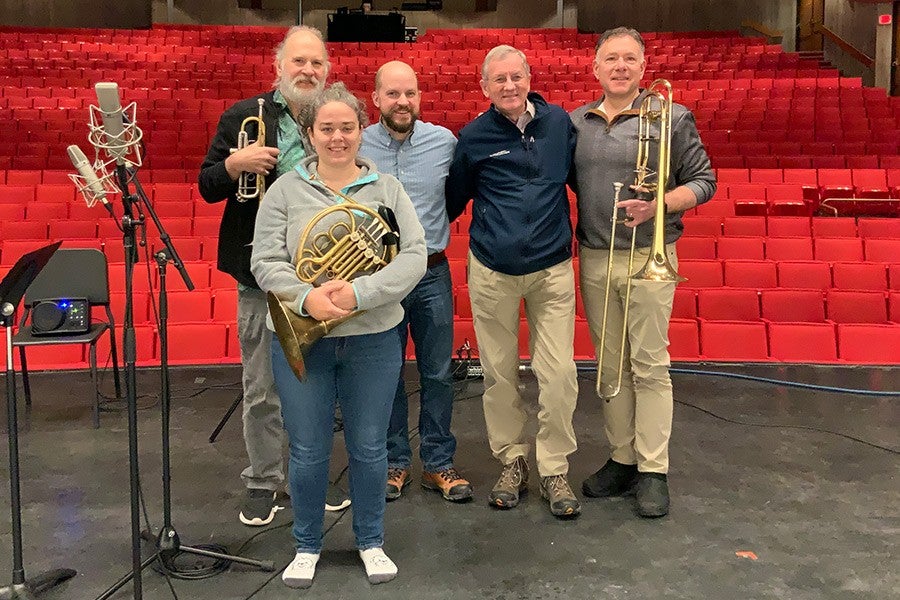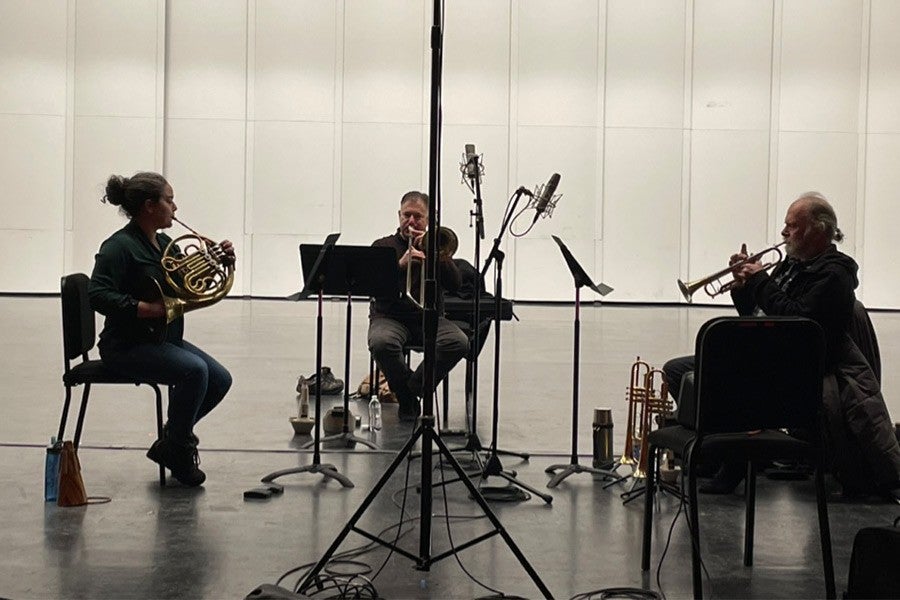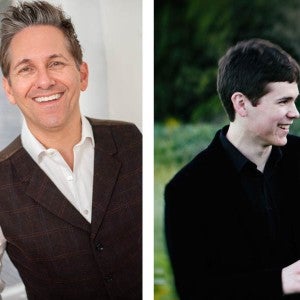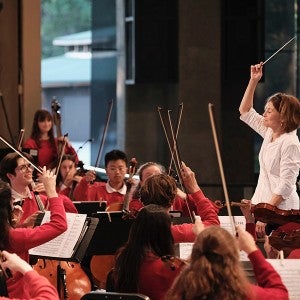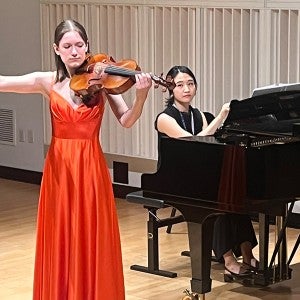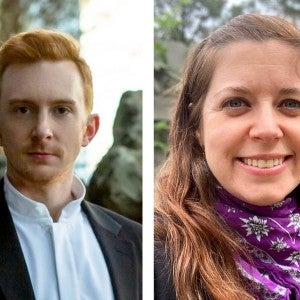Faculty brass trio advances Interlochen, underrepresented composers, and brass repertoire with forthcoming album
Arts Academy brass instructors Lauren Hunt, Ken Larson, and Tom Riccobono recorded works by Gina Gillie, Evan Williams, Eric Ewazen, and more through the Professional Growth Recording Grant.
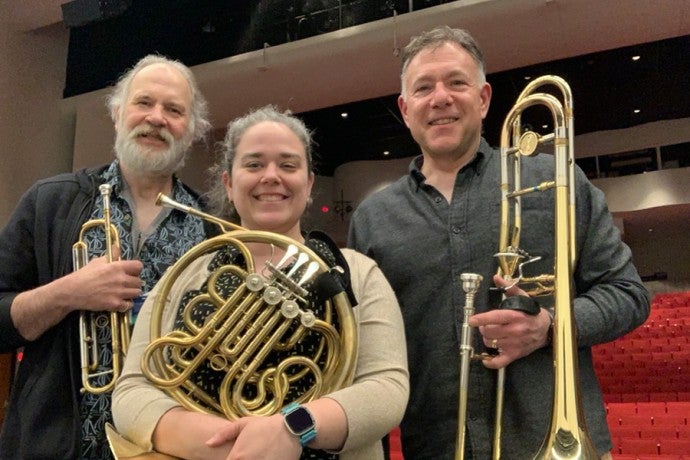
Instructor of Trumpet Ken Larson (left); Linda VanSickle Smith French Horn Chair and Director of Brass Studies Dr. Lauren Hunt (center); and Instructor of Trombone Tom Riccobono pose after a recording session in Corson Auditorium.
When Interlochen Arts Academy Instructor of Trumpet Ken Larson and Instructor of Trombone Tom Riccobono invited hornist Dr. Lauren Hunt to form a faculty brass trio, her response was a resounding “yes.”
“I said, ‘That’s such a great way for us to demonstrate what we’re all about to the community,’” Hunt recalls.
Hunt joined the Academy faculty as the Linda VanSickle Smith French Horn Chair and Director of Brass Studies at the start of the fall 2023 semester and has already taken an active role in the school’s music division: Beyond her teaching and chamber ensemble coaching duties, she maintains a vibrant Instagram profile that offers a behind-the-scenes look at life as a brass student at the Academy and has collaborated with Larson and Riccobono to present informal performances during Brass Hour. Hunt, Larson, and Riccobono have also started brainstorming new ways to help exceptional young brass musicians find their way to Interlochen.
One element of Hunt, Larson, and Riccobono’s student recruitment strategy is a forthcoming album for brass trio, which was supported by the Academy’s Professional Growth Recording Grant. The three instructors collaborated with Senior Recording Engineer Michael Culler and producer Jerry Young to record four works for brass trio in Corson Auditorium this January.
Hunt says the album is not only an opportunity to showcase the talents of Interlochen’s brass faculty, but also to broaden the range of works available for brass trio and highlight underrepresented composers.
“Repertoire is more limited for brass in general, compared to other instruments like violin or piano, but it’s even more limited for brass trio specifically,” Hunt says. “We wanted to venture beyond the standard repertoire for this instrumentation and include some newer works. We were really excited about the idea of finding ways to promote composers who might not otherwise be promoted, or whose repertoire has not been performed as frequently. ”
Hunt began searching through databases of works, placing special emphasis on female and African American composers, and sharing potential selections with her colleagues. Two works captured her attention.
“I fell in love with these two pieces, and wanted to promote them more widely,” Hunt says. “The first is ‘Trio for Brass’ by Gina Gillie. She has two works for brass trio, but the one we really connected with was ‘Trio for Brass.’ It has not been recorded yet, so that was kind of fortuitous.”
The second piece is “Metal Work” by African-American composer Evan Williams.
“The piece is a play on the idea of brass instruments; each movement is named after a different type of metal,” Hunt says. “It’s a minimalist piece with a contemporary aesthetic, which is a cool contrast with what most brass trio repertoire sounds like.”
The trio also recorded Eric Ewazen’s “A Philharmonic Fanfare” and Francis Poulenc’s Sonata for Horn, Trumpet, and Trombone. They also hope to add a fifth piece—an original composition by Arts Academy alumnus Aaron Smith (IAA 00-01, IAC St 01)—to the completed album.
“I think it’s a great piece, and it’s based on his experience here at Interlochen: From his first day on campus to the devastating audition results, all the way to the fond farewells at the end and knowing you’re going to see these people again in your professional life,” Hunt says.
Hunt and her colleagues were not able to record Smith’s piece during their January recording sessions as the piece has not yet been formally commissioned; they’re currently seeking funding to cover the commission and the additional studio hours needed to record the piece. They also hope to use the additional sessions to record short fanfares written by current Arts Academy composition students if time allows.
“We’re planning to include the student-written fanfares on a live performance we have coming up,” Hunt says. “We’re also going to workshop them and collaborate with the student composers and with our composition faculty to model that process.”
Beyond their work with composition students, Hunt says the project offers an opportunity for the Academy’s brass students to gain insight into the life of a working professional musician.
“It’s easy for our students—considering that we’re on a small campus that’s not near to a very large city—to forget that we are artists as well and not just teachers,” Hunt says. “I think it’s cool for them to see us doing the same thing that they’re doing in their own chamber music groups.”
Observing the trio’s dynamic, in particular, provides students with a model of healthy professional relationships.
“As our recording sessions were going on, our students were able to see that we’re busy, and that we’re working together,” Hunt says. “They heard us rehearsing before their lessons. I think that helps them see what we’re doing professionally and how we can get along, even if we might disagree musically about a phrasing idea or something. We can still find ways to resolve that issue in a professional and courteous manner.”
Hunt says that though tensions can run high during recording sessions, Larson and Riccobono’s even-tempered personalities have made working and playing together easier.
“I really could not ask for more positive and supportive colleagues,” she says. “They’re great players, and it’s been a really positive experience working with them, not only on this project, but also in our capacities as teachers.”
Hunt and her colleagues hope to release the album on a label for wider dissemination. They’re also applying for funding to perform as a trio and lead master classes at high-profile music conferences, such as the Midwest Clinic, Texas Music Educators Association (TMEA), International Trumpet Guild Conference, and the International Trombone Festival.
Ultimately, Hunt says, the recording project is an important way for Interlochen’s brass faculty to stay fulfilled artistically—and, in turn, to better serve their students.
“I find when I’m not engaged in my own music-making that I struggle to give my students the energy they need,” Hunt says. “I need to be improving every day as a musician, to be discovering more things about my approach to the instrument, and exploring new repertoire.”
“That’s how I can have the skill set and the tools to help my students.”
Want to be part of the brass program at Interlochen Arts Academy? Start your application today.
